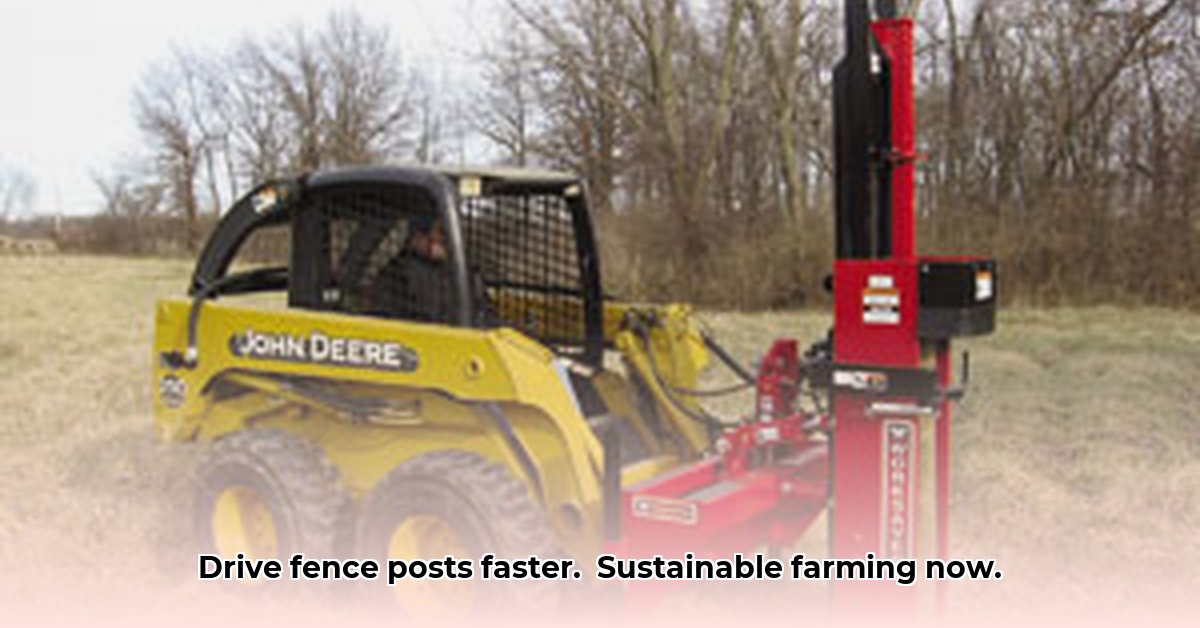
Building fences is laborious, consuming significant time and effort. The Farm King fence post driver tractor offers a solution, promising increased efficiency and reduced manual labor. This review delves into the 1450 and 2400 models, providing a detailed analysis to help farmers decide if this investment aligns with their needs and sustainability goals. For more information on tractor-mounted post drivers, check out this helpful resource.
Power and Productivity: Time Savings and Reduced Labor
Farm King post drivers deliver substantial impact force (up to 100,000 pounds!), dramatically reducing installation time. This translates to significant labor savings – imagine the hours reclaimed for other crucial farm tasks. But how much time will you actually save? That depends on factors like the number of posts and terrain conditions – a thorough assessment of your farming operation is critical before purchasing. Both PTO (power take-off) and engine-driven options offer flexibility, adapting to different tractor setups.
Adaptability and Versatility: A Fit for Your Farm
Farm King post drivers boast compatibility with both 3-point hitch and skid steer attachments, offering broad tractor integration. This flexibility ensures the equipment remains relevant irrespective of your farm's size or future tractor upgrades. Isn't that an appealing aspect of sustainable farming? Investing wisely in tools with adaptable features will extend their lifespan and contribute to economic sustainability.
Environmental Impact: A Critical Unknown
While efficiency gains are obvious, data on the Farm King post driver's environmental impact remains limited. Detailed information on manufacturing carbon footprint, equipment lifespan, and engine-driven model fuel consumption is lacking. This knowledge gap raises concerns regarding the long-term sustainability of utilizing this equipment. Isn't it crucial to have complete transparency on environmental effects before investing? Further research, including comprehensive lifecycle assessments, is essential to fully understand the environmental implications. This would allow for a more informed decision regarding the overall sustainability of adopting this technology.
Cost Analysis: Balancing Investment and Return
The initial purchase price of a Farm King post driver is substantial. Determining ROI(Return on Investment) requires a comprehensive cost-benefit analysis. Include initial purchase price, fuel costs, maintenance, potential repairs, and even operator labor when calculating your financial investment. Exploring leasing options might offer a more manageable financial path for some farms. Carefully weight financial aspects alongside the time saved and potential increase in farming productivity.
Evaluating Your Needs: A Step-by-Step Guide
Before making a purchase, follow these steps:
Assess your needs: How many posts need to be set annually? What are your current labor costs? A realistic estimation ensures an informed decision.
Compare costs: Obtain quotes from multiple suppliers, considering purchase and leasing options. Incorporate projected expenses like fuel and maintenance.
Calculate ROI: Estimate time saved, reduced labor costs, and efficiency increase to project your return on investment.
Consider long-term sustainability: Balance the initial investment against long-term financial and environmental benefits. Look at the total cost of ownership.
Investigate environmental impact: Seek manufacturers providing transparent lifecycle analyses, indicating their commitment to sustainable practices.
Sustainable Fencing Practices: Beyond Efficiency
Efficient fence installation is a core element of sustainable land management. Well-maintained fences enable rotational grazing, reducing soil erosion, promoting healthier pastures, and supporting biodiversity. A fence post driver is more than just a tool; it's part of a holistic, eco-conscious approach to farm management.
The Future of Sustainable Fence Installation
The agricultural equipment industry must prioritize sustainable practices. Manufacturers need to invest in eco-friendly materials, design fuel-efficient machines, and provide transparent lifecycle assessments. Simultaneously, policymakers can encourage sustainable technology adoption through incentives and regulations. This collaborative effort drives innovation and accessibility of sustainable agriculture.
Weighing the Pros and Cons: A Summary
| Pros | Cons |
|---|---|
| Remarkably improved efficiency | High initial cost |
| Adaptability to various tractors | Lack of detailed data on environmental impact |
| Supports sustainable practices | Uncertainty about long-term operational costs |
| Reduced manual labor, minimizing injuries | Missing fuel consumption data for some models |
This review highlights the Farm King post driver's potential, emphasizing the need for more data regarding long-term costs and environmental effects. A thorough assessment of available data and an acknowledgement of data gaps will allow for a well-informed purchase decision.
Calculating ROI: A Practical Approach
Calculating ROI for a Farm King post driver necessitates a detailed cost and revenue analysis. Consider initial cost, financing, maintenance, fuel, labor, and depreciation. Estimate revenue increases from efficiency gains, labor savings, and expanded capacity. Use this formula: (Total Revenue - Total Costs) / Total Investment * 100%. Remember that a longer timeframe will provide a more complete representation of ROI.
Pros and Cons Summarized:
| Pros | Cons |
|---|---|
| Increased efficiency and speed | High initial capital investment |
| Reduced labor costs | Requires specialized skills and training |
| Improved fencing quality | Potential for maintenance and repair costs |
| Potential for increased work capacity | May not be suitable for all terrain types |
| Potential for increased profitability | Dependence on fuel availability |
Ultimately, the decision to invest in a Farm King post driver hinges on a thorough assessment of your farm's specific needs, a realistic cost-benefit analysis, and a thoughtful consideration of both short-term efficiency gains and the long-term implications for environmental sustainability. Further research into the environmental impact of this equipment remains a crucial next step.